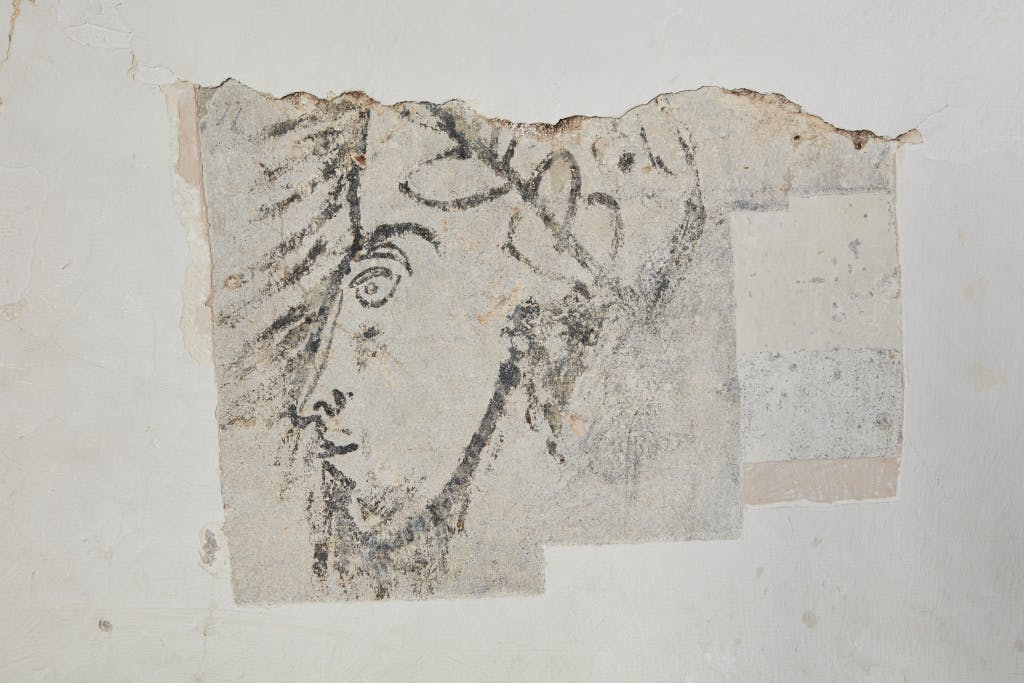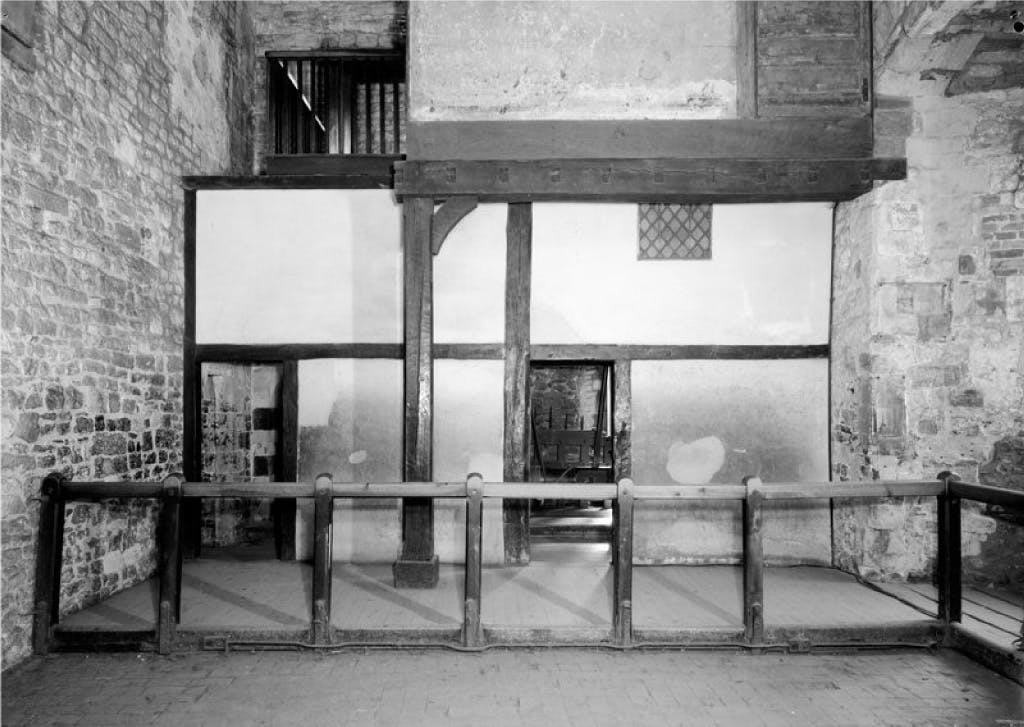A Head in the Bloody Tower
A glimpse of yet another secret
Date: 04 December 2018
Author:
Agnieszka Sadraei
A beautiful and mysterious eye
When I started my job at the Tower of London I fully expected to encounter extraordinary things every day. And true to form I was only onto my second week when a fragment of a wall painting on the upper floor of the Bloody Tower was revealed. I rushed over from my office filled with excitement and there it was: a beautiful and mysterious eye awakened from centuries of slumber under layers of plaster. We knew immediately that we had found something special. But what was it and how did it get there?
Although the preparation for this investigation had begun before I started, I found getting involved with the project provided a great opportunity to hit the ground running in my new role and meet some extraordinary people. A major part of my job is to liaise with Historic England Inspectors and work together with our conservators to gain advice on and negotiate the best course of action for any conservation project at the Tower. We hired the contractor, Andrea Kirkham, a painting conservator with great knowledge of early modern interiors to work on this exciting discovery in the Bloody Tower.
Mrs Raleigh or a Roman Emperor? So many questions...
I couldn't keep away from the Bloody Tower and every morning I rushed in to speak to Andrea who, with great patience, millimetre by millimetre, began to remove fragments of plaster in the areas of existing damage, along the cracks and holes. In the process she discovered a few layers of modern limewash and 1970s pink Carlite plaster, as well as repairing badly damaged plaster at the foot of the wall.
It was clear that I was not the only one who couldn't stay away as a handsome head began to slowly emerge and at every visit I met more and more new colleagues (from Yeoman Warders to Directors) who were animatedly discussing the head's identity: is it Mrs Walter Raleigh? Not convinced... A Napoleonic prisoner? It seems too early... A Roman Emperor? Possibly... The truth is that after two months, even as we uncovered the whole head, we still don't know. There are so many questions to ask! Even Andrea, with her fantastic framework of reference seemed slightly puzzled and said it was certainly unusual.
What we do know
What we do know, just by looking at it, is that the head doesn't seem to be part of an elegant and expensive scheme. However, it is clear that it was painted by someone with a real gift and a good command of drawing technique - the features are well-drawn. But overall, the piece has the air of a quick sketch and was made using cheap materials, seemingly without much preparation.
Built in the early 1220s as Henry III's main Watergate to the fortress, the Bloody Tower became a land gate after 1280, following the construction of the Outer Ward under Edward I. It was later expanded and altered in 1360-2 under Edward III. The most significant post-medieval changes came about when the building became prison to Sir Walter Raleigh at the beginning of the 17th century.
Image: The Bloody Tower today. © Historic Royal Palaces

Accounts testify that in 1605-6 it was divided into two storeys with the insertion of a timber floor:
"Working out of holes in the stone walls of the Bloodie Tower for the endes of the beams and ioysts to bee laid in for anew flowre made there to devide the roome into twoo stories for Sr Walter Rawleigh, working of stone for twoo great stone windows made in the same Tower of two high lights both full of iron barres and lockets gouted fast with lead with a stone table over either window, working up the stone walls on either sides of the said windowes, working a newe doore case of stone the ould being rotten on the walk on Bloody Tower." [PRO E351/3241]
Raleigh's accommodation was rather plush by Tower standards and Mrs Raleigh and his son Wat, as well as their servants, lived with him for a few years. The inner chamber carved out of the corner in the large upper chamber, into which our newly discovered face is gazing, could have been created to give the family more privacy. The partition and most of the fixings seem to be of 17th-century date (as inspected by Lee Prosser, my colleague and an expert building archaeologist). The painting decorates the outer wall of this strange chamber so it cannot be earlier than 1605.
What we also know as result of Andrea's investigation is that the painting seems to be part of the first and original scheme that adorned the external wall of this inner room. She also discovered that one of the layers which later covered 'the black-and-white head scheme' is that of marbling (meaning a painted imitation of a precious marble wall) and this indicates that the large chamber had high status.
Having fun searching for answers
In search for answers I managed to have some 'curatorial fun' by digging around in our own Tower of London's Plan Room and discovered that at the beginning of the 20th century both levels of the Bloody Tower were divided by many more partitions, hand-made cupboards were ordered and fitted and there was a timber staircase (in addition to the existing medieval stone spiral vice) connecting the two. These were removed, together with the 17th-century floor, in c.1914. The floor was reinstated under the supervision of the Department of the Environment in the mid 1970's, using the evidence of joist holes in the walls.
Various sources confirm that Bloody Tower was in residential use, and not only as prisoners' residence. Incidentally, we have found no evidence that prisoners were held here after late 17th-century but it served as accommodation for Yeoman Warders. For instance memoirs of G.D.Trott who lived within the fortress in 1921-36, give an account of ghostly apparitions in the upper chamber of the Bloody Tower seen by Nellie, a young daughter of Yeoman Warder (later Gaoler) Gurney in the 1920s.
My thinking is that there were no prisoners in the Bloody Tower after the 17th century. Many medieval towers have throughout history served as accommodation for Yeoman Warders and we have discovered archaeological and archival evidence that at the end of the 17th century a house for Warders was built into the gap between the Bloody Tower and the so-called Queen's House to the west. Although it was also quite common for the Warders to share their prisoners' accommodation, it may be that constructing a house abutting the Bloody Tower rendered access so awkward that it was no longer seen as fit for incarceration. But this is just a working hypothesis and evidence that proves me wrong may soon come to life.
What the future holds
I would certainly be thrilled to find or learn of any new evidence that would shed light on the post-medieval history of the Bloody Tower and its interior decoration.
So far, working simultaneously on many projects at the Tower of London, I have had little time for more research on this fascinating building and our new discovery. But we will want to understand the scheme and the decorative history of the space and hopefully soon will be able to proceed with our investigation and hopefully figure out the iconography, dating and hopefully also the circumstances of the painting's creation. We do it not only for fun. A thorough understanding of a place, building or an artefact is the key in any conservation or restoration project.
If you come to the Bloody Tower now you will have a chance to appreciate the atmospheric interpretation of the story of Sir Raleigh's imprisonment on the lower level. On the upper floor you will see the head safely ensconced behind a screen to protect it while the building is once more opened to visitors and before further conservation can be undertaken.
The story of this discovery shows why those who work here remain under the Tower of London's spell - even though so many people have been studying it for so many years, it still holds many secrets.
And we love to share the stories, involving our visitors and supporters in finding clues to unseal the secrets. So if you have any ideas, or know of any similar wall paintings, we would love to hear from you!
Agnieszka Sadraei
Historic Buildings Curator (Tower of London)
More from our blog

Caring for the Tower of London through lockdown
11 May 2021
While the Tower of London was closed to the public during the Covid-19 pandemic, much work was underway to protect the fabric of the building and the future of the palace. Assistant Curator Alfred Hawkins reveals one of the important projects that he has been working on behind the scenes.

Secrets of Henry VIII's Whitehall: The Archaeology of a Lost Palace
17 August 2023
More than 300 years after the destruction of Whitehall Palace by fire, archaeological excavation and scientific analysis continue to uncover the lost stories and secrets of Henry VIII's once elaborate home.

Anthony Salvin: the architect who transformed the Tower of London
16 December 2021
Archivist Tom Drysdale introduces Anthony Salvin, the Victorian architect who began the transformation of the Tower of London, and looks at four drawings that shed a light on his work and legacy.



